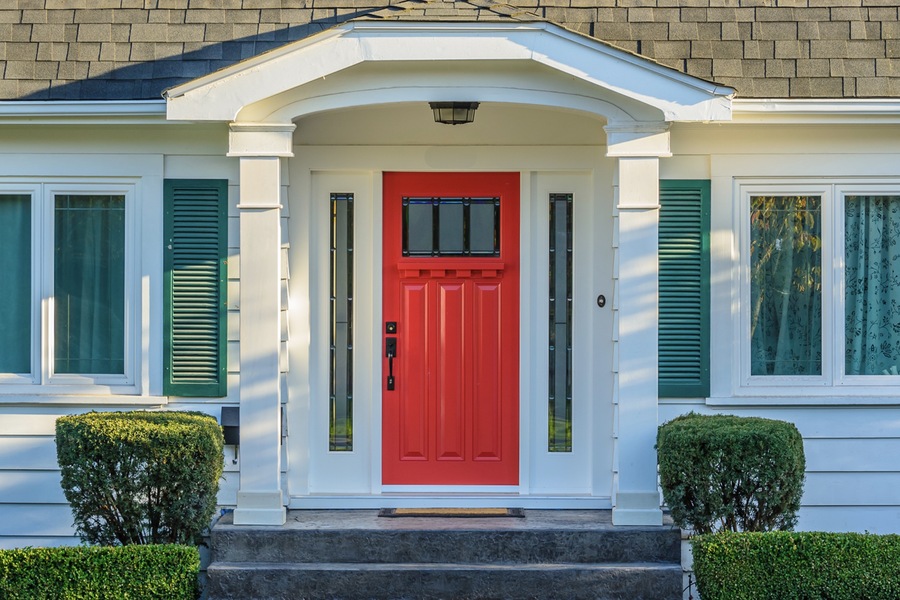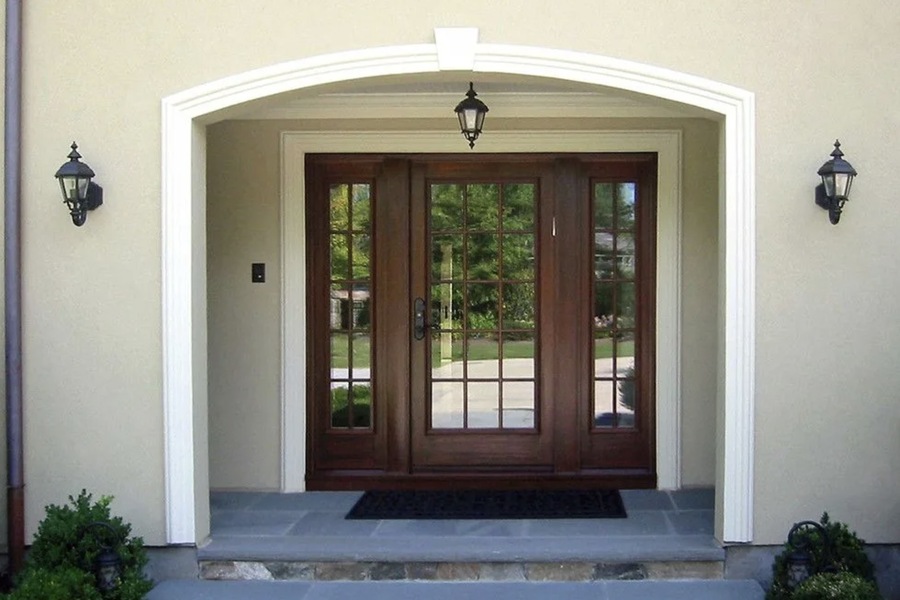The History of Doors
The concept of the door, an essential architectural element, has a rich history dating back thousands of years. The first recorded mention of the word “door” appears in Sumerian chronicles around 3250 BC. One of the oldest surviving examples is a wooden slab that once covered the entrance to an Egyptian tomb’s burial chamber. This early door highlights the fundamental need for security and protection from the elements, a principle that Argus Security continues to uphold with its modern, durable entrance doors.
In ancient Rome, doors were a staple in households, regardless of the owner’s wealth. Even the poorest citizens had entrance doors and several interior doors, signifying their importance in daily life. Excavations in Pompeii have unearthed the first doors equipped with locks and hinges, showcasing the early advancements in door technology. These developments marked a significant step forward in terms of security and functionality.
During the Middle Ages, doors evolved to become decorative elements. Solid-colored metal doors adorned with mother-of-pearl, ceramic mosaics, and stones became common, reflecting the era’s artistic sensibilities. These ornate doors were not only functional but also served as symbols of wealth and status.
In Russia, wooden interior doors with locks and deadbolts became widespread in the VIII-IX centuries, indicating an increased focus on security and privacy within homes. Meanwhile, in monarchical France, the use of transparent glass inserts in doors became popular. The Rococo style, characterized by its elaborate and decorative elements, spread across Europe in the XVII-XVIII centuries, influencing door designs significantly.
The era of the scientific and technological revolution brought about the invention of “self-opening doors” with pneumatic and electric drives. Despite the initial excitement, many of these innovations were too complex for everyday use and did not gain widespread adoption. Nevertheless, they paved the way for future advancements in door technology.
The 20th century in the USA saw the introduction of sliding doors. This innovation was part of a broader trend towards maximizing space and creating more flexible living environments. However, the preference for classic rectangular doors made of wood or more affordable materials eventually overshadowed the trend for hinged doors. Today, a wide variety of door designs and materials are available, catering to diverse architectural styles and functional needs.

Importance of Front Doors
Front doors play a critical role in the security, functionality, and aesthetics of a home. Here are the main aspects that emphasize their importance:
Security
Front doors are the first line of defense against intrusion. Strong, secure doors can significantly reduce the risk of burglary attempts, providing peace of mind for homeowners. Modern security features such as reinforced frames, multi-point locking systems, and advanced materials further enhance a door’s protective capabilities.
Weather Protection
Quality front doors are designed to withstand various weather conditions, protecting the interior of the home from the elements. Weather-resistant materials and finishes help prevent damage from rain, wind, and UV rays, ensuring the door remains functional and attractive for years.
Thermal Insulation and Energy Efficiency
Effective front doors provide excellent thermal insulation, helping to maintain comfortable indoor temperatures by keeping warmth in during the winter and cool air in during the summer. This can also lead to energy savings, as a well-insulated door reduces the need for heating and cooling. Features such as insulated cores, weatherstripping, and energy-efficient glazing contribute to a door’s thermal performance.
Aesthetics and Design
The front door is a crucial component of a building’s architectural style. It can create a lasting first impression and enhance the overall appearance of the property. A well-designed door can complement the home’s exterior and reflect the owner’s personal taste. With various styles, colors, and finishes available, homeowners can choose a door that enhances their home’s curb appeal.
Comfort and Convenience
A good front door should be easy to use, opening and closing smoothly to ensure convenience for residents and visitors alike. Features such as ergonomic handles, smooth hinges, and accessible thresholds contribute to a door’s usability. For added convenience, modern front doors can also be equipped with smart technology, allowing for remote locking and unlocking, keyless entry, and integration with home security systems.
Soundproofing
Front doors can also serve as soundproofing elements, reducing the amount of noise that enters the home from outside. High-quality materials and construction techniques can significantly improve a door’s soundproofing capabilities, creating a quieter and more comfortable indoor environment. This is particularly important for homes located in busy urban areas or near noisy streets.
Fire Safety
Some front door models are designed with fire safety in mind, providing additional protection for life and property in the event of a fire. Fire-rated doors are constructed from materials that can withstand high temperatures and prevent the spread of flames and smoke. These doors are often required in certain building types and can provide crucial escape time during an emergency.

Types of Front Doors
Front doors come in various types, each with its own set of advantages:
Metal Doors
Metal doors, typically made from steel or aluminum, are the most common type. They offer high security, excellent soundproofing, and a variety of finishes to suit different styles. Steel doors are particularly known for their strength and durability, while aluminum doors are lightweight and resistant to corrosion. Both materials can be customized with decorative panels, glass inserts, and various coatings to enhance their appearance and functionality.
Plastic Doors
Plastic doors are a cost-effective alternative to metal and wooden doors. When made with a quality profile, plastic doors can be durable and long-lasting. They are resistant to moisture, making them suitable for areas with high humidity. Additionally, plastic doors require minimal maintenance and can be manufactured in a wide range of colors and designs.
Wooden Doors
Natural wooden doors are stylish and beautiful, suitable for both high-rise apartments and country houses. Commonly made from veneer, options include beech, maple, cherry, or lime. Wooden doors offer a timeless appeal and can be crafted to match various architectural styles. They provide good insulation and can be treated to resist weathering and pests. However, they may require regular maintenance to preserve their appearance and functionality.
Glass Doors
Glass doors can add a modern touch, making them ideal for country houses or entrance vestibules. They allow natural light to enter, creating a bright and welcoming atmosphere. Glass doors can be made with tempered or laminated glass for added safety and durability. Additionally, they can be combined with other materials, such as wood or metal, to create a unique and attractive entryway.
Aluminum Doors
Aluminum doors are perfect for modern and high-tech homes. Despite the stereotype of being fragile, aluminum doors are robust and offer comparable stability to steel models. They are resistant to corrosion and can be finished in various colors and textures to suit different design preferences. Aluminum doors are also lightweight, making them easy to install and operate.
Combination Doors
Combination doors incorporate multiple materials, such as metal and glass or wood and glass, offering a blend of durability and aesthetic appeal. These doors can provide the best features of each material, such as the strength of metal, the warmth of wood, and the light-transmitting properties of glass. Combination doors are highly customizable and can be designed to match any architectural style.
Conclusion
The front door is not just a barrier; it is the shield of your home, providing security, insulation, and a welcoming entrance. From ancient wooden slabs to modern high-tech designs, doors have evolved to meet our needs for protection, style, and convenience. Choosing the right front door involves considering factors such as security, weather resistance, thermal insulation, and design. Argus Security in Dubai offers exclusive entrance doors of unrivalled durability, ensuring your home remains a safe and secure haven. With the right front door, you can enhance your home’s appearance, improve energy efficiency, and provide a strong defense against potential intruders.

Skier, doer, record lover, Bauhaus fan and proud pixelpusher. Working at the fulcrum of simplicity and purpose to develop visual solutions that inform and persuade



